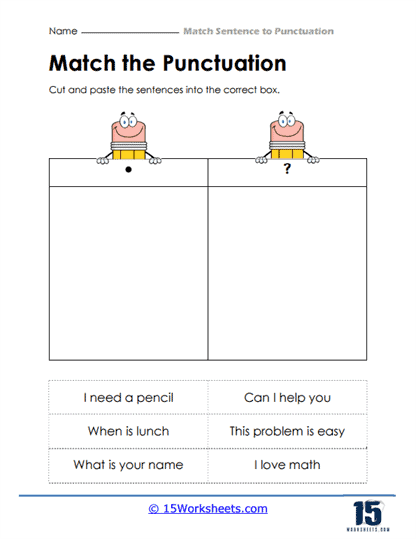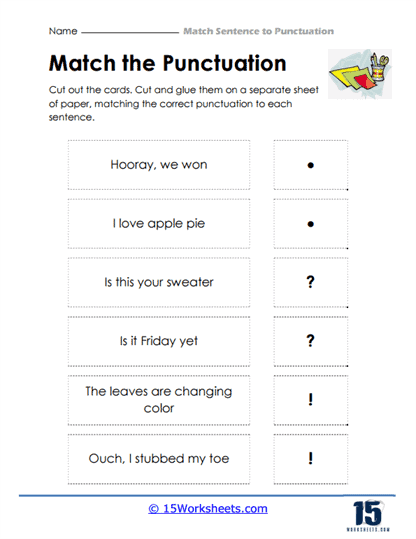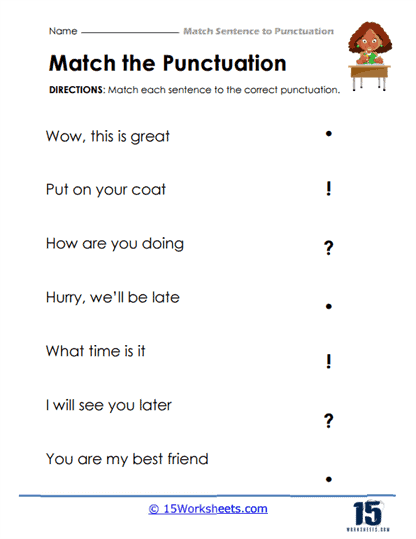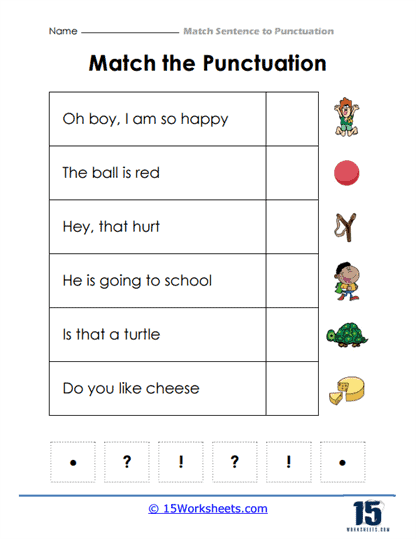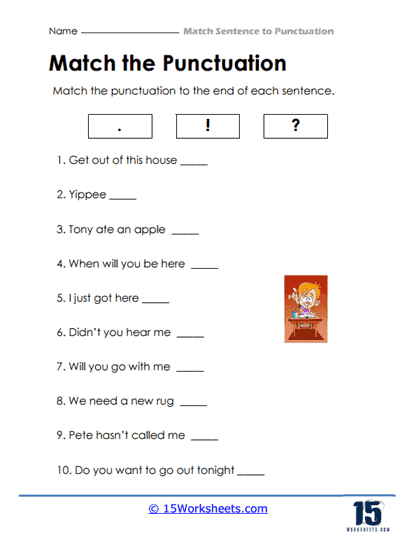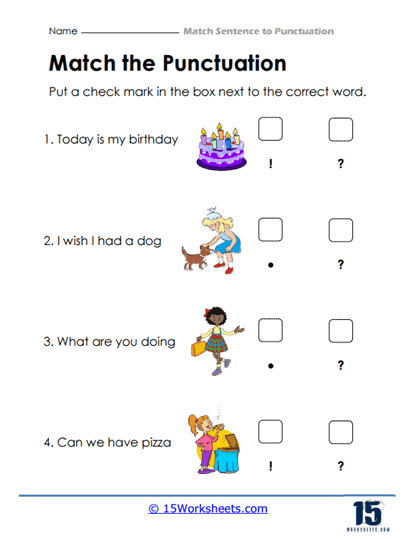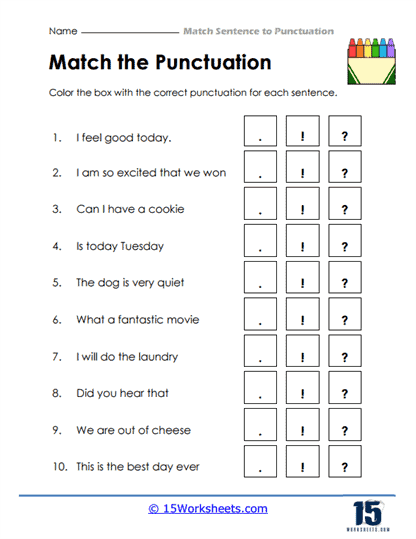Match Sentences to Punctuation Worksheets
About These 15 Worksheets
These worksheets serve as structured learning resources, aiming to enhance students’ punctuation skills in a systematic and engaging manner. The primary objective is to familiarize students with various punctuation marks, such as commas, periods, exclamation points, question marks, quotation marks, colons, semicolons, and ellipses, and teach them how to use these marks appropriately in different contexts. By honing their punctuation skills, students can improve their writing clarity, coherence, and overall effectiveness in conveying their intended messages.
Effective communication is a fundamental skill that everyone should develop, and one of its pillars is proper grammar usage. Within the realm of grammar, understanding how to use punctuation marks correctly is crucial for clear and concise written expression. These worksheets are valuable tools designed to enhance students’ grasp of punctuation and improve their overall writing skills. This essay will delve into the purpose of these worksheets, the various types of exercises they include, and how practicing with them can benefit students by fostering a deeper understanding of grammar and good writing.
Types of Exercises
Match the Sentence to the Punctuation – In this exercise, students are presented with a list of sentences and a corresponding list of punctuation marks. Their task is to correctly pair each sentence with the appropriate punctuation mark, ensuring that the mark is placed in the right position within the sentence. For example, they might need to match a declarative sentence with a period, an exclamatory sentence with an exclamation point, or a question with a question mark.
Punctuate the Dialogue – Dialogue punctuation is a critical aspect of writing, and these worksheets often include exercises that involve punctuating conversations. Students are provided with a dialogue passage and must insert the correct punctuation marks to indicate who is speaking and where pauses occur. This exercise helps them understand how quotation marks and commas are used in dialogue.
Fill in the Blank – In these exercises, students are given sentences with missing punctuation marks, and they must identify the appropriate punctuation and fill in the blanks. This type of exercise reinforces their ability to recognize where punctuation is needed within sentences.
Rewrite the Sentence – In this exercise, students are presented with sentences that are incorrectly punctuated or lack proper punctuation altogether. They must rewrite the sentences with the correct punctuation marks, helping them practice the application of punctuation rules.
Sorting Sentences – Students may encounter exercises that require them to categorize sentences into different groups based on their type (declarative, interrogative, imperative, or exclamatory) and apply the corresponding punctuation marks accordingly. This exercise helps reinforce the link between sentence types and punctuation usage. Some worksheets encourage students to create their own sentences and apply appropriate punctuation marks based on specific instructions or guidelines provided. This exercise fosters creativity while reinforcing punctuation rules.
The Benefits of These Worksheets
Reinforces Punctuation Rules – Regular practice with these worksheets helps students internalize punctuation rules, such as when to use commas in a series, how to punctuate dialogue, and where to place semicolons and colons. This reinforcement leads to more accurate and confident punctuation usage in their writing. Punctuation is a fundamental aspect of language proficiency. Students who master punctuation through consistent practice are better equipped to excel in language arts courses and standardized tests that assess grammar and writing skills.
Improves Sentence Clarity – Proper punctuation ensures that sentences are clear and well-structured. By practicing with these worksheets, students learn how punctuation marks affect sentence meaning and flow, enabling them to communicate their ideas more effectively. Consistent and correct punctuation contributes to the overall coherence of written pieces. As students become proficient in using punctuation marks, their writing becomes more organized and easier to follow.
Builds Editing Skills – Through exercises that involve correcting or rewriting sentences with incorrect punctuation, students develop strong editing skills. This skill is valuable not only for improving their own writing but also for helping peers enhance their work. Matching Sentences to Punctuation Worksheets require students to pay close attention to the details of sentence structure and punctuation placement. This attention to detail is a transferrable skill that can benefit them in various aspects of their academic and professional lives.
Fosters Critical Thinking – Some exercises within these worksheets may present nuanced punctuation choices, challenging students to think critically about which punctuation marks are most appropriate in specific contexts. This critical thinking contributes to their overall writing proficiency. As students practice and become more proficient in punctuating sentences correctly, they gain confidence in their writing abilities. This confidence can lead to a willingness to tackle more complex writing tasks and take risks in their creative expression.







